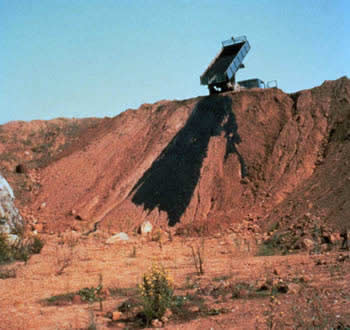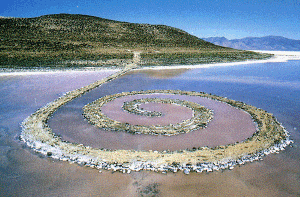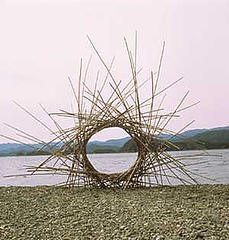| artcornwall | ||
| home | features | exhibitions | profiles | gazetteer | links | archive | ||
| Passivity - An Ecocentric Paradigm for Collaborating with Natural Processes Adam Clarke
Contemporary Ecological Context It is implicit in our nature to search, scrutinize and understand the world we inhabit; an empirical methodology that modern science maintains. Without such challenging existing representational models to advance our evolution and history it is hard to conceive that our civilization would be as advanced as we are today, and possess many of the technologies we so adore and rely on. Over time science has come to disenchant our spiritual, animistic bonds with nature. To quote Friedrich Schiller’s die Entgotterung der Natur, this was the “disgodding” of nature. Nature came to be understood in line with mechanistic philosophies, overtime transforming it from a realm of reverence to an economically viable terrain that man could manipulate to his own end. We now yearn for a spiritual ecology to combat our racing environmental disaster, perpetuated by an industrial egoistic, material scientism. Our individual, everyday activities coupled with swelling industries, leave in their wake devastating residues that infiltrate, affect and damage the Earth’s natural systems and processes. This view has firmly established itself as a consensus that permeates throughout our modern culture.... Within a culture increasingly conscious of prevalent, challenging ecological realities, many contemporary artists respond by questioning their influence upon such issues, debating as to how they can work ecologically, encouraging a social positivism via their practice. Whereas some focus upon forms of activism as their ecological model , others embrace a romantic and provocative poeticism. These artists explore sensitive and sympathetic engagements with nature and the environment as a co-creator, via a collaborative synthesis. Bonding man with the earth via non-dualistic philosophies, they embrace an environmental holistic aestheticism.
Re-enchantment - The Importance of Passive Collaboration By passively engaging with natural processes, collaborating to create with their self-regulating nature, the artist reveals that nature has a potential voice, a secret poetry and story. This form of collaboration is the mechanism for re-enchanting nature; visually realising that nature is not something to be used egoistically, manipulated without regard. Re-enchantment supports an ecocentric ideology that stands in opposition to man’s often de-constructivist, mechanised view of the natural world. Re-enchanting nature and drawing closer to those of an ecological interconnectivity, dependency and reverence, encourages the realisation that nature is a system that is in a constant state of exchange and symbiosis with ourselves. If we are to continue a sustainable existence we should re-consider our detrimental, abrasive interactions with it. Nature has a story more complex and vast than our own; processes fundamentally more important to the planet’s equilibrium than our need for a commodity driven future. Through re-enchanting nature, collaborating passively with its presence and processes, we discover the potential to generate a visual discourse that adheres to an ecological ethic. This enables a greater awareness and depth of understanding regarding the world we inhabit, and the processes constantly occurring around us, those we seldom remember or are aware of. Realising that such natural processes are capable of generating unexpected and influential aesthetics, challenging common perceptions of nature or revealing its presence to us in refreshing, diverse ways, we gain a greater insight into the world we inhabit, acknowledging wonder to be a potential holistic mechanism that can alter our perceptions significantly. The passive collaboration is a non-invasive, sensitive aesthetic participation; an interface between artist and nature in which the artist’s ego and perspective of the world is diminished to a transparency. As he initiates the coaxing of nature’s voice to be revealed, free of human manipulation, he becomes an amanuensis to nature’s ubiquitous, self-regulating and eclectic narratives. This collaborative, yet submissive role evokes and asserts a sympathetic awareness of our presence in the natural world, reiterating a symbiotic relationship with nature, subverting our contemporary dislocation from its existence.
Principles of passive collaboration Contemporary art organizations such as AMD&ART and Meadowsweet Dairy share the philosophy that art should have a function; respectively manifested in a positive environmental change, regenerating sites that have been wounded by the presence of man. Though such practices are admirable, morally conducive to the cultural eco-climate we live in, it is pertinent to assert that such eco-aesthetically inclined practices function from an anthropocentric will to change, manipulate, or heal an environment for what we deem to be of a greater good, or benefit, for nature. It is here that the principal tenet of collaborating passively with nature is established. For the concept is at the polar opposite to any form of manipulation or reclamation of a natural environment. It is far from a permanent physical interface with nature. To elaborate, I assert that there are three principal tenets for passive collaborations to follow: Aesthetics should be created by, or interface with nature’s ubiquitous, serendipitous, self-regulating processes; embracing the lack of control implicit in collaborations with nature. Passive collaborations are not manipulative, permanent, or invasive towards nature and the environment. The artist leaves no trace or mark in nature, working with, and revealing only that which nature itself makes apparent. Passive collaborations must not be to the detriment of nature’s processes or ecology in any way.
Other models of practice - early Land Art Passive collaboration hinges upon one word, collaborating ‘with’ natural processes. I propose that there are degrees by which such a collaboration can take place, and that therefore a framework, or ‘sliding scale’, upon which passivity can be applied and measured needs defining. Therefore, I acknowledge that there are an exorbitant amount of ethical, material and contextual principles that contribute towards defining a passive collaboration. It is poignant to assert that the majority of Land art as passivity’s antithesis. Land art of the 1960’s and 70’s encouraged a ‘… new eco-spirit and a general reaction against the art object as commodity.’ But this eco-spirit came tarnished. The domineering, egoistic thirst to diversify art from a gallery biased commodity, moving out and into nature, often failed to embrace the ecological potential such a poignant, historical shift was capable of generating. Michael Heizer’s ‘Double Negative’ and Robert Smithson’s ‘Spiral Jetty’ are savage examples of an anthropocentric aesthetic that possesses the landscape via an egoistic permanent manipulation of nature and environment; industrial wounds to realise the artist’s own conceptual imaginings. Heizer is quoted as saying “I don’t care about the landscape. I’m a sculptor. Real estate is dirt, and dirt is material.” ; a cold and arrogant statement, from an artist seemingly intent upon individuation through the gross manipulation of entire environments. Installing and creating such megaliths contributed to a highly materialist form of Land Art that can be associated with, and equated to, the disenchantment of nature during The Enlightenment. The savage decadence of Double Negative and Spiral Jetty is echoed in Francis Bacon’s Natura Vexata , an empirical call to force nature to yield its answers, generated through the human desire to conquer, manipulate, and control nature. Such works compete with the immensity of their environment, as opposed to responding to or participating with it with any sense of ecological ardour. Acknowledging the presence of Land arts anthropocentrism, positing much of the movement as polemic to the proposed model, I therefore discuss the following works as I feel they can contribute towards further defining passive collaboration with more accuracy.
Andy Goldsworthy - Collaborative Transient Intervention Andy Goldsworthy’s transient interventions in nature, distinct from those of a more permanent sculptural vein, are sympathetic to the proposed passive model. His temporary manipulation and adoption of natural materials is in direct opposition to Land Art’s permanent manipulation of an environment. Using only found organic materials he deftly reconfigures them, a fleeting aesthetic intervention that is left to be affected by nature’s ubiquitous, self-regulating processes, (namely change, decay and regeneration), interacted with to be returned back into its ecology. There is a synchronic ecology that reaffirms the sense of interconnectivity that a passive collaboration complements, asserting that “I am part of nature…”. In such work Goldsworthy has no desire for nature to retain his mark, there is no want of a monument; as the artist himself has commented, ‘When I work with a leaf, rock or stick, it is not just material in itself, it is an opening into the processes of life within and around it. When I leave it, these processes continue.’ Embracing nature’s ubiquitous cycle of change, Goldsworthy adheres to a superfluous active participation with natural events and processes, intervening to passively create simple, eloquent and dynamic works that do not harm, interrupt or permanently manipulate nature or the environment. Goldsworthy collaborates with natural states of change, creating a form for nature’s processes to respond to. Nature provides the archive of resources enabling his collaboration to take place with natural cycles, a temporal orchestration within a naturally dynamic environment. The collaboration doesn’t occur in the creation of the work, but in its dissolution. In this simple example we can acknowledge that passive collaboration possesses a somewhat dualistic dynamic; they can take place through creation and destruction, via natural forces revealing an aesthetic, and in an ecological aesthetic being returned to the soil.
Giuseppe Penone - Collaboration through Demonstration Giuseppe Penone’s ‘Stone rope sun / Stone rope rain’ (black and white below) is a form of collaboration that differs considerably from the previous models, positing a kinetic, visual demonstration of evaporation. The resulting kin-aesthetic taps into a natural occurrence that is quietly constant, ‘… the liveliness and cosmic force of a small detail of nature…‘ . The rope acts as a muscle upon which contraction and expansion is demonstrated, as generated by the presence of moisture and its subsequent evaporation in the sun. This process, the sun expounding moisture into the air from the rope, enables and fulfils the work’s potential, the process to be conducted. ‘Stone Rope Sun’ (below) collaborates with a natural occurrence, fluctuating in accordance with the site’s atmospheric qualities; adhering to an ecosophy, sympathetic towards the environment, unlike many of Penone’s Land Art contemporaries. The act is a poetic exposition of elegance, the artist collaborating with a natural event to illustrate visually an underlying, everyday occurrence. Can demonstrating a natural occurrence be considered a form of passive collaboration? The work is an articulation of evaporation orchestrated by the artist. He arranges the model for a natural event to interface with; in turn the relationship can be considered collaborative, the process realising the artist’s imaginings. The process by which the stone is lifted is fundamental to the work; without this natural occurrence the work would be redundant. The artist collaborates with nature, to conduct his demonstration.
Conclusion "He who speaks does not know. He who knows does not speak." --The Tao Te Ching Nature’s processes are silent, their language visual or sensed. Such a secret dialect must be observed to be comprehended, be known and experienced intimately. We must listen diligently, with respect and if we are to create with nature, it should be to this end; ‘…the earth cannot be saved by even the most perfect technocratic scheme… confront the apostle of consumption and find the will to live in sustainable ways.’ I have proposed the early beginnings of an ecocentric paradigm, an organic collaborative framework intended as a creative synthesis between artist and nature; suggesting principal tenets that leave nature in its usual dynamic state, unscarred by the inquisitive hand of man. Passive collaboration can be considered a form of conversational drift. It has the potential to communicate a poignant change in perspective towards how we realise, and interact with, nature, re-enchanting its presence, revealing it as an intricate constant that we are inseperable from and interdependent with. Our model craves an ecological shift in artistic thinking, from an anthropocentric view of, to an ecocentric participation with nature. Through re-enchantment we can reawaken our sense of wonder and consider more intimately our bond with it; so making conversational drift a visual re-education, geared towards the emergence of eco-aware models of practice. Awareness and a conscious interconnectedness with nature is essential to the passive vision; its aim to encourage a shift in aesthetics that coaxes the audience to realise that they are participants in, and collaborators with nature, and that its processes and voice are an omnipotent presence. Re-enchanting nature, via collaborating passively with its processes, rather than imposing manmade idealised aesthetics into or upon it, we excavate revealing its story, via its own voice; centred upon an awareness and reverence of nature’s presence. To quote Thomas Berry, ’…re-enchantment with the earth is the necessary condition for its rescue from the impending destruction we are imposing on it.’ I propose the passive model as a sensitive collaborative method to achieve this.
Adam Clarke September 2006 This is an abridged version of the essay which will be available - with references - on Adam's website soon. Link to follow.
|
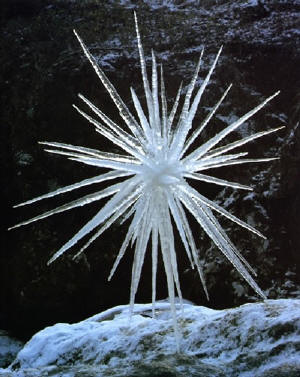
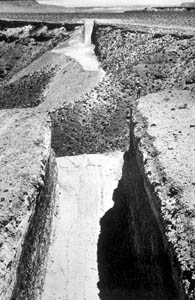 Micheal Heizer
Micheal Heizer